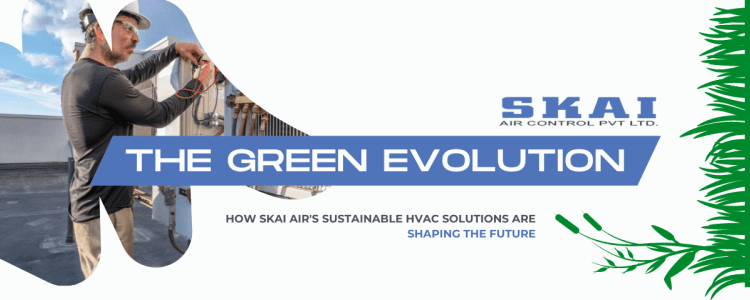
The Green Evolution: How SKAI Air’s Sustainable HVAC Solutions are Shaping the Future
The concept of “sustainable design” has become a buzzword that engineers encounter frequently, with clients increasingly seeking it for their projects. However, sustainability is more than just a matter for individual engineers or consultants. It requires collaboration from the entire building team, including owners and government agencies. Public interest in sustainability has grown significantly, from a niche aspect of the 1970s solar movement to an essential consideration in building-team professional organizations and government procurement policies. As the private sector joins in, sustainability has become a criterion for selecting building teams.
Defining Sustainable Design
In building construction, sustainable design entails employing techniques that, if taken to their fullest extent, will result in buildings that become “net producers” of energy, food, clean water, air, and promote healthier humans and communities throughout their lifetime. While achieving this entirely may not be feasible for most projects, many facility owners are interested in buildings that consume less energy, provide healthier environments, and boost worker satisfaction without incurring higher costs. Sustainable design’s promise lies in creating buildings that demand fewer resources over their lifetimes.
The Impact of Sustainable Design
There are two compelling reasons to embrace sustainable design: environmental benefits and financial gains. The impact of sustainability on operating and personnel costs surpasses the construction cost by far. For instance, a mechanical engineer’s conventional HVAC equipment specification, requiring a megawatt of energy, can be reduced by 20% to 50% through sustainable technology, resulting in substantial savings over the building’s lifetime. Research shows that individual temperature controls, daylighting, and improved indoor air quality lead to increased worker productivity, further justifying the importance of sustainable design.
Challenges and Strategies for Sustainable HVAC
While the benefits of sustainable design are evident, two significant challenges hinder its widespread adoption: compartmentalization and short-term economic goals. To overcome these challenges, a shift towards a whole-building-system approach is necessary. Sustainable HVAC design plays a crucial role in promoting sustainable building performance, focusing on both interior environment and energy-performance categories.
Displacement Ventilation
Displacement ventilation is an HVAC system that uses the natural rising of warm air to displace comfortable low-velocity air upwards after being heated by people and equipment. The displaced air is then transported to a high return or exhaust. This system offers high ventilation effectiveness and low power consumption, although it may require outside-air preconditioning for optimal results.
Geothermal Heat Pumps
Geothermal heat pumps utilize the earth’s internal heat or a body of water to enhance the performance of conventional heat-pump systems. By controlling the heat-pump loop temperature and optimizing the refrigeration system, engineers achieve improved performance. Geothermal loop-field design and system efficiency depend on site and subsurface conditions.
Photovoltaic Systems
Photovoltaic systems are becoming more cost-effective, with integrated photovoltaic systems using roofing or glazing materials as substrates for solar cells, reducing the need for conventional framing systems. Such systems can benefit from solar-cell cooling arrangements that reduce cell temperatures and improve conversion efficiency.
Sustainability Guidelines and Tools
Guidelines and tools assist in creating sustainable building designs, promoting an integrated design process involving the entire building team. The Minnesota Sustainable Design Guide and the U.S. Green Building Council’s Leadership in Energy & Environmental Design guidelines help engineers prioritize and identify sustainable strategies. These tools award points based on sustainability goals, encouraging systems that outperform conventional ones.
The Way Forward
Sustainable HVAC strategies, along with other sustainable design elements, hold the potential to make significant contributions to energy efficiency and overall sustainability. As the industry shifts towards building integration and long-term views, the HVAC industry, including pioneers like SKAI Air, plays a crucial role in shaping a more sustainable future. By embracing innovation, collaboration, and a commitment to environmental responsibility, sustainable HVAC solutions are poised to revolutionize the industry, offering benefits for consumers, the environment, and the bottom line. As we continue on the green evolution, SKAI Air’s dedication to sustainable HVAC solutions sets a high standard for others to follow in achieving a greener and more sustainable future.
